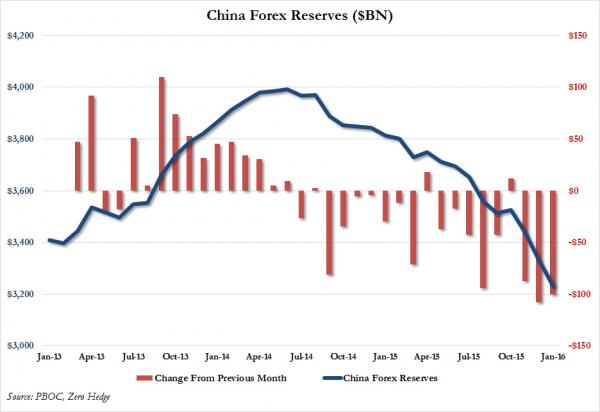As we previewed on Thursday, the biggest event of the week, and perhaps of the month, was not Friday’s nonfarm payroll report, but the January update of China’s FX reserves, relesed by the PBOC. The number came out at $3.2309 trillion, down $99.5 billion from the prior month, and $8 billion less than the December outflow of $107.6 billion.

And even as China added $3.4 billion to its gold reserves, which rose to $63.6 billion or an increase of half a million ounces to 56.66 million, this reduced the total amount of Chinese foreign reserves to the lowest level since May 2012, and down from the $4 trillion peak in the summer of 2014 when the US Dollar started its rapid appreciation on rate hike concerns, and led to nearly a trillion dollars in Chinese capital outflows.

Recently, an important question that has emerged is for how much longer can China sustain its FX intervention before tapping out and letting the hedge funds win with their short Yuan bets once total reserves drop below the critical redline of approximately $2.7 trillion as calculated by the IMF – the answer is between 5 months and 10 months assuming monthly reserve burn rates of $130BN to $60BN.
That, however, is a bridge we will cross some time in the summer of 2016.
For now the real question is what does the January Chinese FX outflow mean for risk come Monday’s open, and how will it affect markets when they start opening tonight, if not in China which is closed for the week for its new year celebrations.
Recall that in our previewed on Thursdaywe warned that according to one of the more prominent bears from BofA, Michael Hartnett, had the reserve outflow come in well below expected, it would unleash a “vicious bear market rally.”
This is what we said:
According to consensus estimates, China will report that its total FX reserves declined to $3.2125 trillion from $3.33 trillion: a drop of $118 billion, or modestly higher than the massive December $108 billion outflow.
In other words, a reported number below, and certainly substantially below, $118 billion for the January outflow and it would be off to the races as a massive short squeeze will grip all the commodity and materials-linked sectors.













Leave A Comment